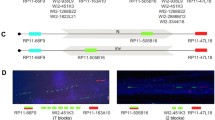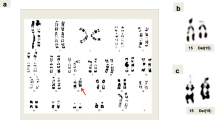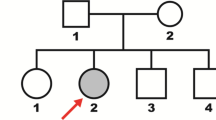Abstract
Velocardiofacial syndrome (VCFS) is a relatively common developmental disorder characterized by craniofacial anomalies and conotruncal heart defects. Many VCFS patients present hemizygous deletions on part of chromosome 22q11.2; suggestive that haploinsufficiency in this region is responsible for this etiology. Most 22q11.2 deletions occur sporadically, although in some cases the deletion may be transmitted. A total of 29 VCFS patients and their parents were genotyped using six consecutive polymorphic markers (STS) of the chromosome 22q11.2: D22S420, D22S941, D22S264, D22S306, D22S425, and D22S257. The results revealed that 72% (21/29) of the patients harbored a deletion involving the polymorphic markers D22S420, D22S941, and/or D22S264. Haplotype analysis showed that among the patients studied, the deletions were either of maternal or paternal origin. Our findings demonstrated that independently of their size, any deletion occurring in the VCFS critical region is enough to confer the patient phenotype.


Similar content being viewed by others
References
Scambler PJ (2000) The 22q11 deletion syndromes. Hum Mol Genet 9:2421–2426
McDonald-McGinn DM, Larossa D, Goldmuntz E et al (1997) The 22q11.2 deletion: screening, diagnostic workup, and outcome of results: report on 181 patients. Genet Test 1:99–108
Shprintzen RJ (2000) Velo-cardio-facial syndrome: a distinctive behavioral phenotype. Ment Retard Dev Disabil Res Rev 6:142–147
Digilio MC, Angioni A, De Santis M et al (2003) Spectrum of clinical variability in familial deletion 22q11.2 from full manifestation to extremely mild clinical anomalies. Clin Genet 63:308–313
Sandrin-Garcia P, Macedo C, Martelli LR et al (2002) Recurrent 22q11.2 deletion in a sibship suggestive of parental germline mosaicism in velocardiofacial syndrome. Clin Genet 61:380–383
Adeyinca A, Stockero KJ, Flynn HC et al (2004) Familial 22q11.2 deletions in DiGeorge/velocardiofacial syndrome are predominantly smaller than the commonly observed 3Mb. Genet Med 6:517–520
Morrow B, Goldberg R, Carlson C et al (1995) Molecular definition of the 22q11 deletions in velo-cardio-facial syndrome. Am J Hum Genet 56:1391–1403
Carlson C, Papolos D, Pandita RK et al (1997) Molecular analysis of velo-cardio-facial syndrome patients with psychiatric disorders. Am J Hum Genet 60:851–859
Carlson C, Sirotikin H, Pandita R et al (1997) Molecular definition of 22q11 deletions in 151 velo-cardio-facial syndrome patients. Am J Hum Genet 61:620–629
Edelman L, Pandita RK, Morrow BE (1999) Low-copy repeats mediate the common 3 Mb deletion in patients with velocardiofacial syndrome. Am J Hum Genet 60:1076–1086
Shaikh TH, Kurahashi H, Saitta SC et al (2000) Chromosome 22-specific low copy repeats and the 22q11.2 deletion syndrome: genomic organization and deletion endpoint analysis. Hum Mol Genet 9:489–501
Shprintzen RJ, Goldberg R, Lewin ML et al (1978) A new syndrome involving cleft palate, cardiac anomalies, typical face, and learning disabilities: velo-cardio-facial syndrome. Cleft Palate J 15:56–62
Emanuel BS, McDonald-McGinn D, Saitta SC et al (2001) The 22q11.2 deletion syndrome. Adv Pediatr 48:39–73
Shprintzen RJ, Goldberg R, Young D et al (1981) The velo-cardio-facial syndrome: a clinical and genetics analysis. Pediatrics 67:167–172
Lipson HA, Yuille D, Angel M et al (1991) Velocardiofacial (Shprintzen) syndrome: an important syndrome for the dysmorphologist to recognize. J Med Genet 28:596–604
Sandrin-Garcia P, Richieri-Costa A, Tajara EH et al (2007) Fluorescence in situ hybridization (FISH) screening for the 22q11.2 deletion in patients with clinical features of velocardiofacial syndrome but without cardiac anomalies. Genet Mol Biol 30:21–24
Sugama S, Namihira T, Matsuoka R et al (1999) Psychiatric in patients and chromosome deletions within 22q11.2. J Neurol Neurosurg Psychiatry 67:803–806
McDonald-McGinn DM, Kirschner R, Goldmuntz E et al (1999) The Philadelphia story: the 22q11.2 deletion: report on 250 patients. Genet Couns 10:11–24
McDonald-McGinn DM, Tonnessen MK, Laufer-Cahana A et al (2001) Phenotype of 22q11.2 deletion in individuals identified through an affected relative: cast a wide FISHing net! Genet Med 31:23–29
Ryan AK, Goodship JA, Wilson DI et al (1997) Spectrum of clinical features associated with interstitial chromosome 22q11 deletions: a European collaborative study. J Med Genet 34:798–804
Demczuk S, Levy A, Aubry M et al (1995) Excess of deletions of maternal origin in the DiGeorge/velo-cardio-facial syndromes: a study of 22 new patients and review of the literature. Hum Genet 96:9–13
Saitta SC, Driscoll DA, Rappaport EF et al (2000) The 22q11.2 deletion: parental origin and meiotic mechanism. Am J Hum Genet 67:163S
Vogels A, Fryns JP (2002) The velocardiofacial syndrome: a review. Genet Couns 13:105–113
Gottlieb S, Emanuel BS, Driscoll DA et al (1997) The DiGeorge syndrome minimal critical region contains a goosecoid-like (GSCL) homeobox gene that is expressed early in human development. Am J Hum Genet 60:1194–1201
Pizutti A, Novelli G, Ratti A et al (1997) UFD1L, a developmentally expressed ubiquitination gene, is deleted in CATCH 22 syndrome. Hum Mol Genet 6:259–265
Yamagishi H, Garg V, Matsuoka R et al (1999) A molecular pathway revealing a genetic basis for human cardiac and craniofacial defects. Science 283:1158–1161
Halford S, Wilson D, Daw S et al (1993) Isolation of a gene expressed during early embryogenesis from the region of 22q11 commonly deleted in DiGeorge syndrome. Hum Mol Genet 2:1577–1582
Merscher S, Funke B, Epstein JA et al (2001) TBX1 is responsible for cardiovascular defects in velo-cardio-facial/DiGeorge syndrome. Cell 104:619–629
Liao J, Kochilas L, Nowotschin S et al (2004) Full spectrum of malformations in velo-cardio-facial syndrome/DiGeorge syndrome mouse models by altering Tbx1 dosage. Hum Mol Genet 13:1577–1585
Paylor R, Glaser B, Mupo A et al (2006) Tbx1 haploinsufficiency is linked to behavioral disorders in mice and humans: implications for 22q11 deletion syndrome. Proc Nat Acad Sci 103:7729–7734
Dunham I, Collins J, Wadey R et al (1992) Possible role for COMT in psychosis associated with velo-cardio-facial syndrome. Lancet 340:1361–1362
Baker K, Baldeweg T, Sivagnanasundaram S et al (2005) COMT val108/158met modifies mismatch negativity and cognitive function in 22q11 deletion syndrome. Biol Psychiat 58:23–31
Acknowledgments
This work was supported by grants from the Fundação de Amparo à Pesquisa do Estado de São Paulo (FAPESP-Brasil) and Conselho Nacional de Desenvolvimento Científico e Tecnológico (CNPq). P.S.G. received a fellowship from FAPESP-Brasil (97/13599-3). The authors would like to thank all the families of the patients for their cooperation.
Author information
Authors and Affiliations
Corresponding author
Rights and permissions
About this article
Cite this article
Sandrin-Garcia, P., Abramides, D.V.M., Martelli, L.R. et al. Typical phenotypic spectrum of velocardiofacial syndrome occurs independently of deletion size in chromosome 22q11.2. Mol Cell Biochem 303, 9–17 (2007). https://doi.org/10.1007/s11010-007-9450-5
Received:
Accepted:
Published:
Issue Date:
DOI: https://doi.org/10.1007/s11010-007-9450-5




